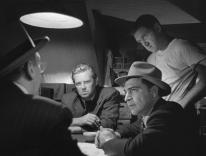Of the cohort of boyish leading actors we’ve spent the last decade waiting to see turn into men, Matt Damon is the most surprising. For someone blessed with all-American good looks and a brash, winning grin, he can be surprisingly inward, repressed, or weird-or, as in the Jason Bourne trilogy, haunted and violent. Maybe such ambiguities suit the American character at this particular moment, when our sunny and dark sides seem to run so close to one another.
In The Bourne Identity (2002), Damon’s character was rescued from the Mediterranean by a French fishing boat. He had two bullets in his back, a case of total amnesia-and, embedded under the skin of his hip, a capsule containing the number of a safety deposit box in a Zurich bank. In the deposit box he discovered half a dozen passports, a couple hundred thousand dollars in various currencies, and a gun. What kind of person carries all that around with him? he wondered aloud to his newfound German girlfriend, Maria (Franka Potente). Hmm. Probably not a veterinarian on vacation, anyway.
In that film and in the 2004 sequel, The Bourne Supremacy, Damon ran, swam, leapt, karate-chopped, shot, and strangled his way toward the mystery of his identity. The final installment of the trilogy, The Bourne Ultimatum, finds him zeroing in on some high-ranking culprits, convinced by now that his amnesia was not simply the result of having been shot, but of a far more sinister trauma. “Something happened to me,” he says, “and I need to know what it was.”
Helping him out at first is an investigative reporter in London who has coaxed a CIA source into revealing the existence of a top-secret training program called “Blackbriar,” of which Bourne appears to have been the first graduate. The movie follows Bourne’s cat-and-mouse games with the CIA higher-ups who run the program and are bent on killing him to keep it secret. Good luck. If the team of crack assassins thrown at Bourne in the first two installments could not do the job, who thinks anyone can now?
The Bourne movies got a large jolt of adrenaline after the first episode, when director Paul Greengrass took over from Doug Liman; and Ultimatum is the most kinetic of the three. Its stylized visuals are set to pulsing music, and even exposition seems done on steroids. In one montage, flashback scenes of Bourne kissing Maria are intercut with later images when he breathes into her mouth after she drowned (she was shot while driving across a bridge). Then we see nightmare glimpses of a hooded captive being waterboarded in a CIA interrogation room. There’s also a heart-stoppingly suspenseful sequence filmed in Waterloo Station, in which Bourne uses a cell phone to try to guide the British journalist through a maze of agents bent on neutralizing him.
Villainy is more openly on display here than in the two earlier movies, and the audience cheers as Bourne consistently outfoxes his pursuers. These include both the “assets” in the field and the bosses coolly directing them from Washington and Manhattan, where a CIA deputy director named Noah Vosen (David Straithairn) heads a “deep cover” anti¬terrorism office running covert operations from a state-of-the-art control room. The CIA depicted here displays both ruthless efficiency and a matchless speed in tracking down leads: if someone half a world away so much as utters the word “Blackbriar,” agents will be at his door within minutes. Can this be the same CIA whose data-sharing failures kept it from recognizing in its own intelligence data the two future 9/11 hijackers who had slipped into the United States?
But never mind. Villainy must be efficient to be truly villainous, and the political morality of The Bourne Ultimatum is kept securely in high-contrast black and white. “What is Blackbriar?” demands Pam Lundy (Joan Allen), a midlevel agency manager who isn’t in on the program, and doesn’t like what she is discovering. Vosen ticks off the agenda: “rendition, experimental interrogation, lethal action if necessary...and no more red tape.” He stifles her objections with a familiar refrain. “You know how real the danger is. We need these programs.”
And thus the Bourne trilogy, first filmed in the aftermath of 9/11, shows its political hand, addressing an America led astray by fear into the new age of torture, black sites, and a reckless contempt for constitutional restraints on power. “This isn’t what I signed up for,” insists Lundy about Blackbriar. “This isn’t us.” Without being heavy-handed-and without sacrificing one iota of Hollywood entertainment-The Bourne Ultimatum turns one man’s lost identity into a suggestive national metaphor. Somehow Blackbriar turned Bourne into a pure killing machine, unconstrained by a personal history. Yet the conceit of the trilogy is that his training and the lethal skill set it gave him are at war with his deep inner humanity. “I can see their faces,” he says, staring at his own swollen and bloodied hands after dispatching an assassin from the rooftops of Tangier. “I can see everyone I ever killed.” The implicit contrast between our soldiers and our civilian leaders couldn’t be clearer. Where Straithairn’s Vosen is a national-security bureaucrat dishing out lethality from the cosseted safety of his office, Bourne must act in the hot spots where men break into homes whose inhabitants recoil in terror, and “neutralizing” someone means breaking real bones and spilling real blood.
The spy thriller is a genre that arguably should have died fifteen years ago, and its continued popularity seems an anachronism at first glance. I wonder if the hyperkinetic pace of The Bourne Ultimatum mirrors upscale American tourism today, with its whirlwind destinations and plugged-in stress. I’m in Goa! I’m in Moscow! I’m in Naples! I’m in Berlin! Does the American traveler toting his Blackberry through the capitals of Europe feel like Jason Bourne on the run? The more serious question posed by the trilogy, of course, is that of who we Americans are in the world right now. Written (by Robert Ludlum) in the 1980s, in the last gasp of the cold war, the three Bourne novels chart corrupt oil deals, vast sums of money at stake, political assassinations, and cover-ups-and the machinations of our government, directing all this soullessness with slick treachery, promulgating a dark worldview in which survival trumps all niceties of civilization, including the law. I guess we can thank the Bush administration for breathing new life into the genre. We have seen the enemy, and he is us.
If there is something new in the twenty-first-century spy thriller, it may be the unwillingness to indulge in throwaway violence. (Even the James Bond franchise has taken tongue out of cheek and presented violence as a soul-killing pathology.) Paul Greengrass directed Bloody Sunday and United 93, and although it remains a glitzy Hollywood product, The Bourne Ultimatum shares with them a fundamental seriousness about the subject. Beneath the propulsive pleasures of the film lie unsettling thoughts about the human capacity for doing deathly harm. It’s what gives Jason Bourne his haunted, death-in-life look as he metes out death to yet another bad guy in yet another foreign locale. His plight mirrors that of a nation that has lost its way and its self. Even the all-American boy can be turned into a killing machine, if you can get him to forget where he came from and who he is.
Please email comments to [email protected] and join the conversation on our Facebook page.
Previous Story
Telling It Right
Next Story
Authentically Fake


